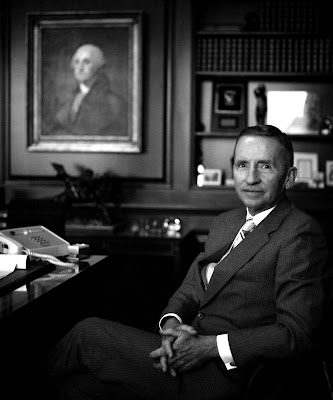Francis I. duPont & Co. Genealogy: Part XIV
William R. Staats & Co., Continued
The Entry of Ross Perot, Continued
 |
| Ross Perot in his office, by Allan Warren. |
In January 1971, duPont family members led by Anthony duPont, Edmond's son, tried to withdraw their capital from the firm. Perot was outraged. He said, "[The duPont family] knew I wanted to do this thing in the national interest. They would have been wiped out if I hadn't come in, but when I did they looked on me as someone pouring money into a funnel so they could take it out at the bottom." As The New York Times stated, "The Perot group, of course, had no intention of keeping its own money in the firm, inasmuch as the group's funds had kept duPont afloat. The duPont family interests and other principals would not have had anything to consider pulling out, had the Perot group not prevented the firm's failure." The NYSE leadership became intermediaries in the conflict and tried to impress upon the duPont family interests the seriousness of the situation. Felix Rohatyn of Lazard Fréres, who was a member of the NYSE Board of Governors, said, "An elaborate game of chicken was being played. You had this feeling that you were watching two cars running down the white line at terrific speed toward each other and that the worst was inevitable." A power struggle ensued, which Perot won, but the outcome also increased his commitment to the future of the firm.
An agreement was reached in March 1971 where a bank syndicate led by Chase Manhattan bank assisted in refinancing the firm. The following month, F.I. duPont, Glore Forgan was incorporated. The agreement stated that "PHM & Company, a vehicle controlled by Perot and two other E.D.S. executives, agreed to invest up to $40 million in duPont in return for between 80 and 90 percent of the firm's stock." The NYSE also agreed to indemnify Perot's group up to $15 million, which would be paid if needed through "an assessment on the exchange's membership." Years later, it was discovered that President Nixon's administration had also become involved and pressured Perot to save the firm because they were worried that F.I. duPont's collapse would cause a panic on Wall Street and shatter public confidence in the economy.
Edmond duPont did not see Perot's takeover as a rescue and announced that he and his family were considering legal steps to block it. Edmond also took to the press, openly declaring that he had been wiped out and that he was living on Social Security. He wanted the firm to assume $3.1 million in loans he had taken out from two commercial banks and pay damages. He eventually did file suit against Perot and others in December 1971. The following year, Edmond was himself sued – along with duPont Glore Forgan, Inc., the NYSE and other duPont partners – by Howard Hirsch and two other former partners of Hirsch & Co., who accused them of misrepresenting F.I. duPont & Co.'s financial position before the Hirsch merger. Lawsuits related to the mergers would continue for years to come.
DuPont Walston (1973)
In the midst of the firm's troubles, Perot took over Walston & Co. (founded 1932, San Francisco). E.D.S. received a contract to take over Walston's back office in 1971, which the executives had agreed to do with the expectation of a cash infusion from Perot, which was realized when Perot bought an interest in the firm in 1972.




Comments
Post a Comment